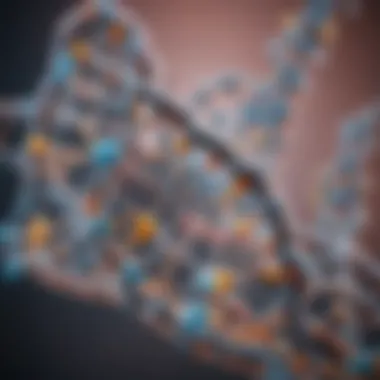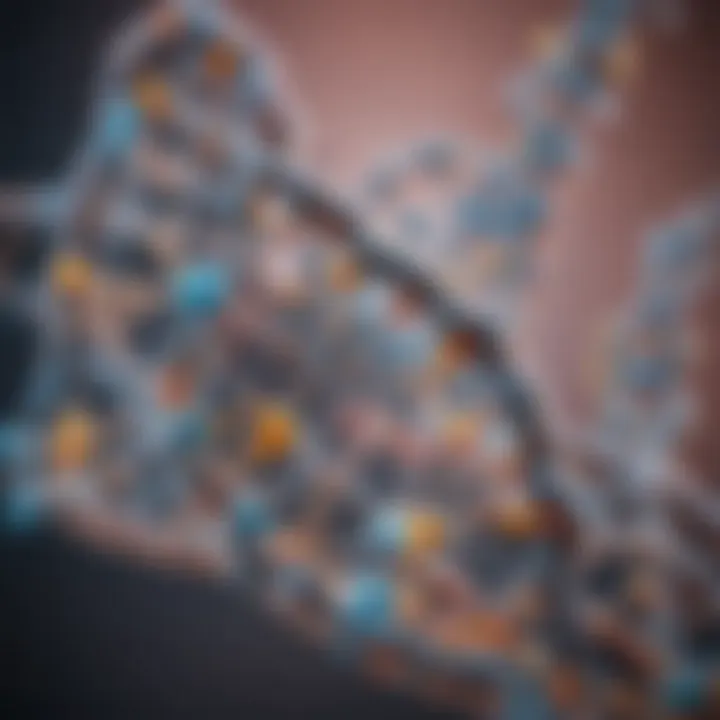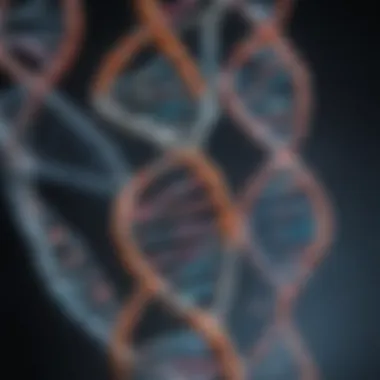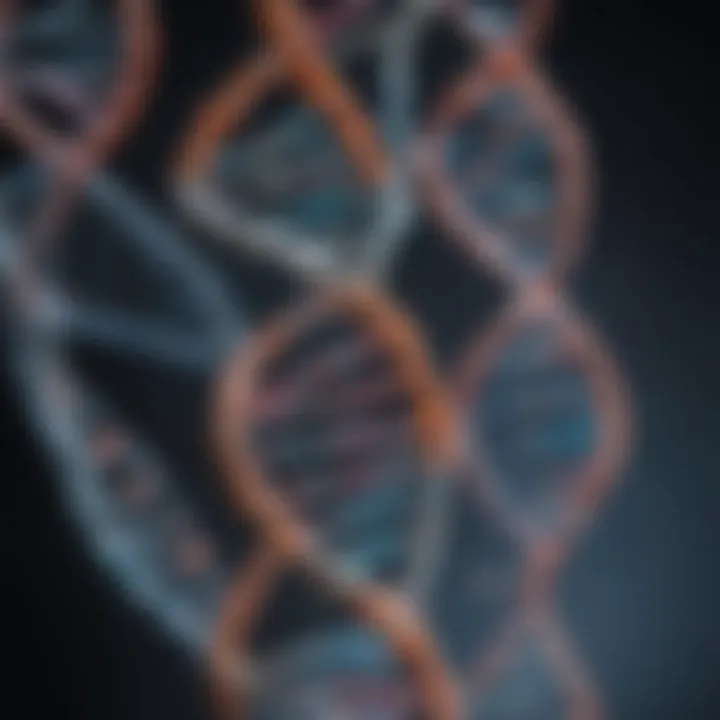Chemical Structure of DNA: An In-Depth Exploration


Article Overview
The study of DNA's chemical structure remains fundamental in understanding biology, genetics, and evolution. This article aims to lay out a comprehensive narrative that explores this intricate topic. We delve into the building blocks of DNA, the distinctive double helix formation, and the biochemical interactions that contribute to DNA's stability. Moreover, we evaluate how this molecular architecture influences genetic encoding and replication and its broader implications in evolutionary biology.
Purpose of the Article
The primary purpose of this article is to provide a thorough overview of DNA's chemical structure. By analyzing the constituent parts of DNA—from the nucleotides to the double helix—we aim to enhance the reader's understanding of these critical components. This analysis takes into account how DNA functions at a molecular level, as well as its implications for life sciences, thereby encouraging a multi-faceted appreciation of this vital molecule.
Relevance to Multiple Disciplines
DNA's structure is not only pertinent to genetics and molecular biology, but also intersects with various disciplines such as:
- Biochemistry: Understanding the interactions between molecules.
- Genetics: Exploring how DNA encodes traits and hereditary information.
- Evolutionary Biology: Investigating the role of DNA in evolution and species variation.
- Bioinformatics: Analyzing DNA data through computational methods.
Thus, the implications of DNA's structure extend far and wide, offering insight into multiple scientific realms.
Research Background
Historical Context
The exploration of DNA began in the late 19th century, though it was the mid-20th century that marked a pivotal moment. In 1953, James Watson and Francis Crick proposed the double helix model of DNA, based on previous work by Rosalind Franklin. This landmark discovery propelled the study of genetics into a new era, making the chemical structure of DNA a central focus of scientific investigation.
Key Concepts and Definitions
To navigate this exploration effectively, several key concepts must be defined:
- Nucleotide: The basic building block of DNA, consisting of a sugar, phosphate group, and nitrogenous base.
- Double Helix: The twisted ladder-like structure of DNA, formed by two strands running in opposite directions.
- Base Pairing: The specific pairing of adenine with thymine, and cytosine with guanine, which stabilizes the DNA structure.
Understanding these foundational concepts is critical for appreciating the complexities that follow.
Prolusion to DNA Structure
The structural framework of DNA stands at the forefront of molecular biology. Understanding this structure is paramount, as it governs the functions of living organisms. It serves not only as the carrier of genetic information but also as a template for reproduction and protein synthesis. Without a grasp of DNA's structure, insights into heredity, genetic variation, and the underlying mechanisms of life would be severely limited.
The Significance of DNA
DNA, or deoxyribonucleic acid, is a molecule that encodes the instructions necessary for the development and functioning of living organisms. Its significance is multidimensional. On one hand, it serves as the blueprint for building proteins, which perform crucial roles in cellular structure and function. On the other hand, it holds the keys to hereditary information, allowing for the transmission of traits across generations. The understanding of DNA has direct implications in various fields such as genetics, forensics, and biotechnology. As researchers decode the complexities of this molecule, they unlock potentials for advancement in medicine, agriculture, and environmental science.
Basic Composition of DNA
The basic composition of DNA consists of four primary components: nucleotides, sugars, phosphates, and nitrogenous bases. Each nucleotide comprises a phosphate group, a sugar molecule, and one of four nitrogenous bases: adenine, thymine, cytosine, or guanine.
- Nucleotides are the fundamental units of DNA. When bonded together in a strand, they form the sequences that convey genetic information.
- Sugars include deoxyribose, which differentiates DNA from RNA. The structure of deoxyribose is essential because it maintains DNA's stability in the cell.
- Phosphates link nucleotides, forming a backbone for the DNA strand. This linkage contributes to the overall structure and stability of the molecule.
- Nitrogenous Bases pair in specific combinations (adenine with thymine, and cytosine with guanine) to form the rungs of the DNA ladder.
Understanding these components is crucial because they play a direct role in the replication process, gene expression, and the stability of genetic material. Each aspect of DNA's composition contributes to its ability to bind, store, and transmit genetic information effectively.
Nucleotide Units
Nucleotide units are fundamental to understanding the chemical structure of DNA. They serve as the building blocks from which DNA is constructed. Each nucleotide comprises three key components: a sugar, a phosphate group, and a nitrogenous base. The intricate arrangement of these components not only forms the DNA structure but also plays a crucial role in how genetic information is stored and transmitted.
The significance of nucleotide units extends beyond mere structural contributions; they facilitate the complex biological processes such as DNA replication and protein synthesis. Understanding the specific elements of nucleotides helps in grasping how genetic information is encoded and expressed within living organisms.
Components of Nucleotides
Sugars
Sugars are an essential component of nucleotides, providing the backbone to the DNA structure. In DNA, the sugar present is deoxyribose. This five-carbon sugar is distinct because it lacks one oxygen atom compared to ribose, found in RNA. The absence of this oxygen makes deoxyribose more stable and less reactive, which is beneficial for the integrity of DNA over time. The key characteristic of sugars in nucleotides is their role in linking the phosphate groups and nitrogenous bases, forming a linear chain. A unique feature of deoxyribose is that it allows for the formation of a rigid structure that is crucial for DNA's functionality. This property provides advantages for molecular stability but can limit its flexibility in certain biochemical interactions.
Phosphates
Phosphate groups are another critical aspect of nucleotides, contributing to the overall structure and stability of DNA. Each phosphate is linked to the sugar molecule, forming the phosphodiester bond that connects nucleotides together. The key characteristic of phosphates is their charged nature, which enables the DNA molecule to be hydrophilic. This property allows DNA to interact efficiently with water, an essential factor for biological processes. A unique feature of phosphates is their ability to confer negative charges, facilitating the overall stability of the double helix structure. However, this negative charge can make the DNA molecule sensitive to environmental factors, which is a notable consideration in genetic engineering and manipulation.
Nitrogenous Bases
Nitrogenous bases are crucial in defining the genetic code and consequently in determining the functioning of organisms. There are four types of nitrogenous bases in DNA: adenine, thymine, cytosine, and guanine. Each base pairs specifically with another base: adenine with thymine and cytosine with guanine. This pairing is vital for the double helix's stability and for the storage of genetic information. The key characteristic of nitrogenous bases is their ability to form hydrogen bonds with their complementary pairs, creating the rungs of the helical ladder of DNA.
A unique feature of nitrogenous bases is that their sequence encodes specific genetic information, which can lead to variation in traits among organisms. This encoding ability is advantageous as it allows for evolution and diversity, essential for adaptability in changing environments. However, mutations in these bases can lead to genetic disorders, emphasizing the importance of maintaining the integrity of nitrogenous bases within the DNA structure.


Types of Nitrogenous Bases
Purines
Purines are one of the two categories of nitrogenous bases present in DNA, consisting of adenine and guanine. These bases are larger, characterized by a double-ring structure. The significance of purines lies in their ability to form stable hydrogen bonds with pyrimidines, which are crucial for maintaining the integrity of the DNA double helix. A notable characteristic of purines is their presence in both DNA and RNA, indicating the shared evolutionary heritage of these important biomolecules. The advantage of having purines in DNA is that their size and structure enhance the stability of the base-pairing mechanism, allowing for efficient genetic encoding and replication.
Pyrimidines
Pyrimidines, the other category of nitrogenous bases, include cytosine, thymine, and uracil, with thymine being specific to DNA. Pyrimidines are characterized by a single-ring structure, making them smaller than purines. The role of pyrimidines is equally critical in DNA, especially in base pairing with purines during the formation of the double helix. Their smaller size facilitates the tight packing of nucleotides, allowing for a compact structure essential for DNA's functionality. However, the inherent instability of some pyrimidines, like uracil, necessitates the maintenance of thymine in DNA to ensure genetic fidelity.
Understanding both purines and pyrimidines allows researchers to explore the complexities of genetic coding and mutation, shedding light on the mechanics of evolution and inheritance.
"The distinct properties of nucleotide components underline the importance of DNA as the molecule of life, encapsulating the genetic blueprint essential for all biological functions."
"The distinct properties of nucleotide components underline the importance of DNA as the molecule of life, encapsulating the genetic blueprint essential for all biological functions."
Integrating knowledge about nucleotides into broader studies of molecular biology illuminates the intricate design and functionality of DNA, hence advancing our grasp of genetic science.
Double Helix Structure
The double helix structure of DNA is pivotal in understanding its chemical architecture and biological functions. This unique configuration allows DNA to store vast amounts of genetic information efficiently. The double helix ensures fidelity during DNA replication and enables the precise encoding of proteins. In many ways, the design of the double helix is the key to life itself, influencing not only how organisms develop but also how they evolve over generations.
The Discovery of the Double Helix
James Watson and Francis Crick
James Watson and Francis Crick are renowned for their groundbreaking discovery of the double helix in 1953. Their work was essential because it provided the first model that explained how DNA could replicate reliably. The model illustrated the complementary nature of the nucleotide bases, which can pair accurately. This aspect is significant as it highlights the basis for the genetic code. One key characteristic of their model is the helical structure that they proposed, making it a popular choice for explaining DNA's properties. This unique feature enhances its stability and allows it to pack tightly within the cell nucleus. However, there were criticisms of their methods, notably the underappreciation of other scientists' contributions, which has implications in discussions about scientific ethics.
Rosalind Franklin's Contribution
Rosalind Franklin's contributions were equally important to the discovery of the double helix. She used X-ray diffraction to visualize the structure of DNA, producing critical photographs that revealed its helical shape. The clarity of these images provided evidence that helped support Watson and Crick's model. Franklin's work is a beneficial aspect of DNA research history, as it highlights the importance of rigorous methodology. The unique feature of her findings laid the groundwork for understanding the molecular structure of DNA. However, her role has often been overshadowed, which raises discussions about recognition within scientific communities.
Mechanics of the Double Helix
Base Pairing
Base pairing describes the specific interactions between nitrogenous bases in DNA. Adenine pairs with thymine, while guanine pairs with cytosine. This complementary base pairing is fundamental for DNA's stability and integrity. One key characteristic of base pairing is the hydrogen bonds that form between these bases, contributing to the overall structure. This aspect is crucial, as it enables accurate replication and transcription of genetic information. The uniqueness of base pairing lies in its specificity, which reduces errors during replication. Yet, the simplicity of this pairing system belies the complexity of its implications in genetic variability.
Antiparallel Orientation
Antiparallel orientation refers to the opposite directionality of the two strands in the double helix. This property is vital for the function of enzymes during replication and transcription. Each strand runs in opposite directions, which is essential for enzymatic processes like polymerization. Its key characteristic is that it facilitates proper base pairing and enzymatic action. This orientation is a beneficial choice, as it allows for simultaneous processes during replication. However, the antiparallel nature can complicate the understanding of how regular DNA copying occurs, especially for those new to molecular biology.
Chemical Bonds in DNA
Chemical bonds form the foundation of the DNA structure, determining its stability and functionality. Understanding these bonds provides insight into how DNA replicates, expresses genetic information, and undergoes mutations. Here, the focus will be on covalent and hydrogen bonds, examining their roles in creating the distinct architecture of DNA.
Covalent Bonds
Covalent bonds play a crucial role in the DNA backbone. These strong connections give DNA its structural integrity.
Phosphodiester Bonds
Phosphodiester bonds are a specific type of covalent bond found in the backbone of DNA. They connect the phosphate group of one nucleotide to the hydroxyl group on the sugar of another. This creates a continuous sugar-phosphate backbone crucial for structural stability. The key characteristic of phosphodiester bonds is their ability to withstand the torsion and tension experienced during DNA replication and transcription. This strong bond makes it a favored choice in biological systems, ensuring that the genetic material remains intact through numerous cellular processes. A unique feature of phosphodiester bonds is their directionality; the DNA strand has a 5' to 3' orientation, facilitating accurate replication and encoding of genetic information. While these bonds are typically stable, they can be broken under extreme conditions, which can lead to mutations.
Sugar-Base Bonds
Sugar-base bonds, also known as glycosidic bonds, connect the sugar component of a nucleotide to a nitrogenous base. These bonds allow the sequencing of genetic information within DNA. The key characteristic of sugar-base bonds is their selectivity for nitrogenous bases, which determine the genetic code. This selectivity makes them a beneficial choice for maintaining genetic fidelity. The unique feature of sugar-base bonds is that they are relatively weaker than phosphodiester bonds, allowing for the necessary flexibility during the processes of transcription and replication. While this flexibility is an advantage for genetic expression, it also makes them prone to hydrolysis under certain conditions, which can lead to errors in DNA encoding.
Hydrogen Bonds
Hydrogen bonds are essential for the stability of the DNA double helix. These weaker bonds allow for the specific pairing between complementary bases and play a role in the overall structure of DNA.
Base Pair Interactions
Base pair interactions occur via hydrogen bonds between nitrogenous bases across the two strands of DNA. Adenine pairs with thymine, forming two hydrogen bonds, whereas cytosine pairs with guanine, forming three hydrogen bonds. This specific pairing is critical for accurate DNA replication. The key characteristic of base pair interactions is their ability to form a consistent width throughout the double helix, contributing to its uniform structure. This consistency makes it a popular choice in studies of genetic coding and stability. A unique feature of these interactions is the way they balance stability and flexibility. While hydrogen bonds hold the strands together, they can also be broken during replication, allowing the DNA strands to separate. However, such breaks must be controlled, as excessive disruption can lead to instability in the genetic code.
Stability of the Double Helix
The stability of the double helix is largely due to hydrogen bonding between the base pairs and the stacking interactions among adjacent base pairs. This stability is necessary for the integrity of genetic information over time. The key characteristic contributing to the stability of the double helix is the collective strength of numerous hydrogen bonds and stacking interactions, making it resilient yet dynamic. This resilience is a beneficial trait for DNA, allowing it to withstand various biochemical processes while maintaining its functionality. However, environmental factors such as temperature and pH can affect stability, leading to potential denaturation of the helix under extreme conditions. Overall, understanding these aspects of DNA's chemical bonds enhances the comprehension of its crucial roles in genetics, replication, and cellular functions.


DNA Replication Process
The DNA replication process is a critical mechanism in molecular biology, serving as the foundation for genetic continuity in living organisms. Each time a cell divides, it is essential for the genetic material to be accurately copied. This aspect ensures that daughter cells receive identical copies of DNA, maintaining the genetic integrity across generation.
Enzymatic Mechanism
DNA Polymerase
DNA Polymerase is a key enzyme in the replication process. Its primary role is to synthesize new DNA strands by adding nucleotides complementary to a template strand. This enzyme exhibits high fidelity, meaning it makes very few mistakes during DNA synthesis. One notable characteristic of DNA Polymerase is its ability to proofread as it goes, correcting any errors that might occur during replication. This feature reduces the error rate significantly, making it a favorable choice for ensuring the accuracy of genetic replication.
The unique feature of DNA Polymerase is its requirement for a primer to initiate synthesis. This means it cannot start adding nucleotides without an existing strand. This characteristic can be both an advantage and disadvantage. The advantage is that it maintains a high degree of accuracy by ensuring that nucleotides are added only to an existing strand. Conversely, the requirement for a primer can limit the speed of initial DNA strand synthesis during replication.
Helicase
Helicase plays a vital role in unwinding the double-stranded DNA, allowing replication to proceed. This enzyme specifically unzips the DNA helix by breaking the hydrogen bonds between the bases, creating two single strands. Its activity is essential for the accessibility of the template strands to DNA Polymerase.
The key characteristic of Helicase is its rapid unwinding ability. This allows the replication fork to advance swiftly, which is particularly important in cells that divide rapidly. A unique feature of Helicase is that it utilizes energy derived from ATP hydrolysis to perform its function. Though Helicase is crucial, it faces challenges, such as the ability to unwind extremely stable DNA regions efficiently. This can slow down the overall replication process in certain instances.
Semiconservative Replication
The concept of semiconservative replication refers to the nature of DNA replication where each new DNA molecule consists of one original strand and one newly synthesized strand. This model was confirmed through experiments conducted by Matthew Meselson and Franklin Stahl. Semiconservative replication ensures that each daughter DNA molecule retains one parental strand, which contributes to the fidelity of genetic information passed down during cell division.
Functionality of DNA Structure
The structure of DNA is not only an architectural wonder; it serves critical functionalities essential for life. Understanding these functions contextualizes DNA’s role in genetics, replication, and overall biological processes. Each component of this structure contributes to its efficiency and reliability. The DNA molecule, primarily recognized for encoding genetic information, also plays crucial roles in cell behavior, hereditary transmissions, and even evolution.
Genetic Encoding
Codons and Amino Acids
Codons are sequences of three nucleotides in the DNA that specify which amino acids will be added next during protein synthesis. Each codon corresponds to a specific amino acid or a stop signal in the protein assembly process. This three-letter code is fundamental, as it lays the groundwork for translating genetic information into functional proteins.
One key characteristic of codons is their universality; the same codon typically corresponds to the same amino acid across almost all living organisms. This makes codons a beneficial choice for explaining genetic encoding in this article.
A unique feature of codons is their redundancy; multiple codons can encode the same amino acid. This inherent property adds a layer of robustness to the genetic code, minimizing the impact of mutations. However, this redundancy can also lead to challenges in interpreting mutations, as not all alterations will cause a functional difference in the resulting protein.
Role in Protein Synthesis
Transcription
Transcription is the first step in the process of protein synthesis. During transcription, the DNA sequence of a gene is copied to produce a complementary RNA strand. This process is central to the functioning of DNA as it translates the genetic blueprint into actionable information for cellular machinery.
A key characteristic of transcription lies in its selective nature; only specific genes are transcribed into RNA depending on the needs of the cell. This makes transcription a popular choice for discussing functionality in this article, as it highlights how DNA regulates itself in response to environmental or internal cues.
The unique feature of transcription involves the enzyme RNA polymerase. This enzyme reads the DNA template and synthesizes a single-stranded RNA molecule. While transcription is highly efficient, errors can occur and lead to the production of non-functional proteins. Nonetheless, mechanisms exist to correct these mistakes, illustrating the complex regulatory processes inherent in cellular biology.
Translation
Translation follows transcription and involves converting the mRNA sequence into a chain of amino acids, ultimately forming a protein. Ribosomes catalyze this process, reading the sequence of codons on the mRNA to produce a corresponding polypeptide chain.
One characteristic of translation is that it requires several components, including transfer RNA (tRNA) and various ribosomal proteins. This multi-faceted nature makes translation an essential focus for this article, emphasizing how numerous elements within the cellular environment collaborate to synthesize proteins.
The unique feature of translation lies in its precision. Each tRNA molecule carries a specific amino acid that matches the codon sequence on the mRNA. This specificity ensures that proteins are built accurately. However, like transcription, translation is susceptible to errors, which can have significant biological consequences, such as producing dysfunctional proteins.
In summary, understanding the functionality of DNA structure highlights the intricate relationships between DNA’s composition, its mechanisms, and their implications in living organisms.
In summary, understanding the functionality of DNA structure highlights the intricate relationships between DNA’s composition, its mechanisms, and their implications in living organisms.
By emphasizing these sophisticated processes, this article provides a comprehensive view of how DNA transcends mere genetic material, actively influencing life processes.
DNA and Genetic Variation
The topic of DNA and genetic variation holds significant importance in the context of this article. It sheds light on the mechanisms that underpin biological diversity. Understanding genetic variation is crucial for exploring how traits are inherited and expressed in organisms. It also helps in comprehending evolutionary processes and environmental adaptations.
Genetic variation arises from different factors, including mutations and recombination. These processes introduce new alleles into populations, which can lead to changes in traits over generations. Such variation is essential for natural selection, driving evolutionary change. Moreover, it influences genetic health, allowing populations to adapt to changing environments.
Mutations
Mutations are fundamental changes in the DNA sequence. They can be classified into several categories, each having distinct implications for genetic variation.


Types of Mutations
There are several types of mutations, including point mutations, insertions, deletions, and duplications.
- Point Mutations: These involve a change in a single nucleotide. Point mutations can result in silent, missense, or nonsense mutations, impacting protein function.
- Insertions and Deletions: These mutations add or remove base pairs in the DNA sequence, which can cause a shift in the reading frame during protein synthesis.
- Duplications: This involves a segment of DNA being copied, resulting in additional genetic material.
The key characteristic of these types is their ability to introduce variations in traits. This is a beneficial aspect of mutations, making them central to the discussion in this article. Each type of mutation has unique features that affect genetic diversity. For instance, while point mutations may have minimal effects, insertions and deletions can significantly alter gene expression. The implications of these mutations influence both individual organisms and populations.
Implications for Evolution
The implications of mutations for evolution are profound. They provide the raw material for natural selection to act upon. Mutations can lead to advantageous traits that improve survival and reproduction in specific environments.
A critical aspect of these implications is their role in genetic drift and population dynamics. For example, small populations are more affected by genetic drift, which can lead to a loss of genetic variation. This is particularly relevant in conservation biology, where maintaining diverse genetic pools is vital for species survival. The unique feature of mutations in evolutionary terms lies in their unpredictability; they can lead to rapid adaptations or deleterious effects that reduce fitness. Both aspects must be considered in this context to understand evolutionary trajectories fully.
Recombination
Recombination is another crucial process for genetic variation. It occurs during sexual reproduction when homologous chromosomes exchange segments of DNA. This shuffling of genes increases genetic diversity within a population.
The result of recombination is an array of genetic combinations in offspring, which is essential for evolution. By producing individuals with unique genotypes, recombination enhances the ability of populations to adapt to new challenges and changes in their environments.
Applications of DNA Understanding
The applications of understanding DNA's chemical structure are vast and significant. DNA is not merely a structure to study; it serves critical roles in various fields including genetics, medicine, and biotechnology. These applications show how DNA knowledge can transform practical approaches towards health, agriculture, and even law enforcement.
In Genetic Engineering
Genetic engineering stands as one of the most prominent applications of DNA understanding. This field utilizes the knowledge of DNA to manipulate organisms at the molecular level. Scientists can add, modify, or remove genes from an organism’s genome.
One specific benefit of genetic engineering is the development of genetically modified organisms (GMOs). These organisms often exhibit desired traits such as pest resistance or increased nutritional value. For instance, genetically modified crops like Bt cotton and golden rice illustrate how altering DNA can lead to improved agricultural outcomes. Moreover, the precision of techniques such as CRISPR-Cas9 allows for targeted edits, minimizing unintended consequences in the genome.
However, genetic engineering also poses ethical concerns. There is worry about the long-term effects of altering DNA in organisms and its impact on biodiversity. As such, while genetic engineering provides promising advancements, careful consideration is necessary.
In Medical Research
Medical research has greatly benefited from insights gained from DNA structure. Two particularly notable areas are gene therapy and personalized medicine.
Gene Therapy
Gene therapy represents a revolutionary approach to treating diseases by directly altering the genes responsible for those ailments. The key characteristic of gene therapy is its ability to target specific genetic mutations that cause diseases. This therapy often involves delivering new or modified genes into patient cells using vectors like viruses.
One of the most beneficial aspects of gene therapy is its potential to offer long-lasting solutions. By correcting the underlying genetic cause of a disease, it can potentially provide a permanent cure rather than temporary symptom relief.
However, gene therapy has unique challenges. The delivery methods must be safe and effective, ensuring that the new genes perform the intended function without adverse effects. Despite these challenges, gene therapy remains a promising field that could reshape treatment paradigms for genetic disorders.
Personalized Medicine
Personalized medicine builds on the foundation of DNA understanding by tailoring medical treatment to the individual characteristics of each patient. This approach considers genetic variation when determining the most effective treatment. One key aspect is its focus on the unique genetic makeup of individuals, which influences their response to medications and therapies. This specificity presents a significant advantage in providing care that minimizes side effects and maximizes efficacy.
A unique feature of personalized medicine is pharmacogenomics, which studies how genes affect a person's response to drugs. By considering a patient’s genetic profile, doctors can select medications that are most likely to be effective for them. This results in a more accurate, efficient, and safer approach to treatment.
Still, challenges persist in implementing personalized medicine widely. Issues such as genetic privacy and access to genetic testing must be addressed to ensure that all patients benefit equally from these advancements.
"Understanding DNA is the key to advancing genetic engineering and personalized medicine, leading to breakthroughs that could profoundly affect health care and agriculture."
"Understanding DNA is the key to advancing genetic engineering and personalized medicine, leading to breakthroughs that could profoundly affect health care and agriculture."
Culmination
The conclusion serves as a critical focal point in this article, summarizing the intricate details surrounding the chemical structure of DNA. It encapsulates the essence of DNA's molecular makeup, emphasizing its role as the genetic blueprint for living organisms. Understanding DNA's structure is not merely an academic exercise; it has profound implications for many fields such as genetics, medicine, and evolutionary biology.
In terms of specific elements, the conclusion must reinforce how the double helix structure, with its covalent and hydrogen bonds, maintains stability and integrity within the genetic material. This structure is pivotal for encoding genetic information, which gets translated into proteins essential for all cellular functions. The repercussions of a faulty DNA structure can lead to mutations, affecting not only individual organisms but also populations over generations. This understanding is pivotal for future research and application in fields such as genetic engineering and medical advancements.
Moreover, considerations about the conclusion involve acknowledging how the insights gained from DNA's structure prompt ongoing inquiries into genetic manipulation, therapy advancements, and personalized medicine. The implications for further understanding genetic variation and its role in evolution cannot be overstated. Advancements in technology open new frontiers for research into DNA's structures, leading to innovative solutions for medical challenges, preservation of biodiversity, and more.
Summary of Key Points
- DNA's structure is central to its function: The double helix model, featuring base pairing, explains how genetic information is stored and replicated.
- Chemical bonds are foundational: Covalent and hydrogen bonds play a crucial role in maintaining the stability and fidelity of the genetic code.
- Impacts of DNA on health: Understanding DNA enables advancements in medical research and genetic engineering, paving the way for therapies and genetic modifications.
Future Directions in DNA Research
The future of DNA research is ripe with possibilities, driven by rapid advancements in technology and an enhanced understanding of genetic material. Below are some anticipated trends and directions:
- Gene Editing Technologies: Techniques such as CRISPR-Cas9 are revolutionizing genetic modifications, allowing for precise alterations in DNA, which hold potential for treating genetic disorders.
- Synthetic Biology: The field is moving towards creating synthetic organisms. This involves reconstructing the DNA of organisms to produce new bio-based products.
- Personalized Medicine: Tailoring medical treatments based on individual genetic makeup is becoming more feasible, promising better outcomes and less adverse effects.
- Genome Sequencing: As sequencing technology improves, broader applications in understanding complex diseases, population genetics, and evolutionary biology will emerge.
- Bioinformatics: Analyzing large datasets generated from genetic sequencing will lead to new insights into genetic variations and disease correlations.
By delving deeper into these areas, researchers are likely to unlock further mysteries of DNA. The implications of these advancements will influence health, agriculture, and biodiversity moving forward.



